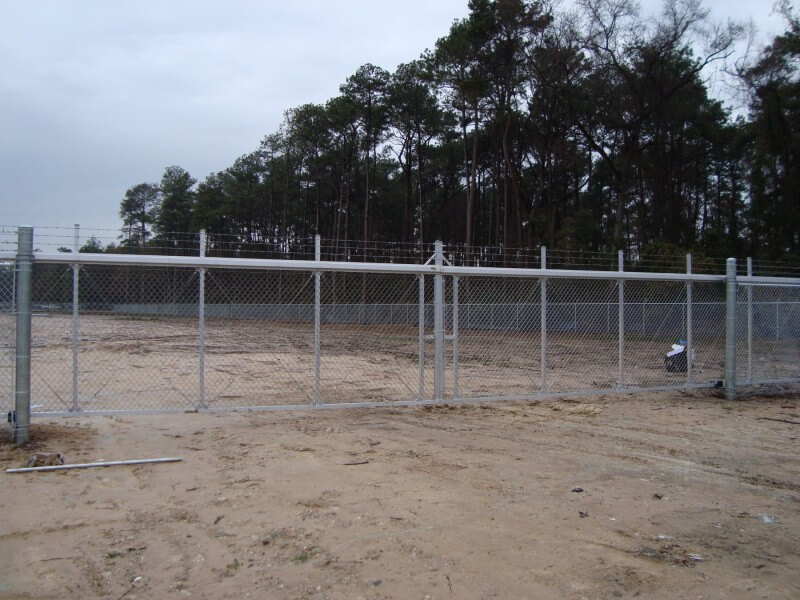Chain Link Fence Repair: How to Fix Your Fence
Chain link fences are known for their durability and affordability, making them a popular choice for many homeowners and businesses. But like anything exposed to the elements, they can suffer from wear and tear over time. As resilient as they are, even chain link fences aren’t immune to the occasional damages from wildlife, weather, or even wear-and-tear.

Understanding Chain Link Fence Damage
Chain link fences are highly durable and can last for many years with proper care and maintenance. However, despite their resilience, they can still sustain damage over time due to several reasons. Understanding the type of damage your fence has sustained is essential before embarking on repairs.
Some of the common causes of chain link fence damage include exposure to extreme weather conditions, UV radiation from the sun, rust or corrosion, impact from sports activities or vehicles, and vandalism. While some forms of damage like cuts, tears, and holes may be easy to identify, others like rust damage may not be as apparent.
In most cases, the extent of chain link fence damage determines whether it needs repairs or requires replacement. For example, minor dents or scratches may only require sanding or repainting to restore the fence’s appearance. On the other hand, severe damage like large punctures would mean that you need to replace a damaged section. Therefore, understanding the type of damage is critical in determining whether you can handle the repair job yourself or call in professionals.
Like human skin damages in chain link fences are also classified into various types. A scratch is different from a cut, just as a dent is different from a tear. But more severe injuries like deep cuts require advanced medical care while treating scars can be done at home. Similarly, while minor damages on your chain link fence might be prone to DIY repair methods, extensive wear and tear might require professional intervention.
Knowing what kind of damages your chain link fences went through lays down a foundation for effective repair works.
Identifying Common Damage Types
Identifying specific damages on your chain link fence would greatly help in making the right call on the kind of repairs needed. The following are common damages that can occur to your chain link fence:
Rust Damage: Rust is one of the main culprits behind fence deterioration. It starts when water and air come into contact with metal components of your fence, creating a chemical reaction that weakens the iron bonds in steel. Over time, rust eats through the metal, creating holes and weakening support structures.
Impact Damage: Your fence can face collision from external objects like vehicles or even heavy winds. The damage may take various forms like bending or breaking of poles and weakened support braces.
Loose Parts: Some parts of your fence, including nuts, bolts, and brackets, can become loose and fall off over time. This may affect the integrity of your chain link fence’s structure.
Identifying common types of damages not only allows you to diagnose what’s wrong with your chain link fence but also helps you identify which parts you will need for repair works. Without proper identification and diagnosis, it would be difficult to achieve an effective repair job on your chain link fence.
It is important to note that some damages can be challenging to identify visually, especially those in hidden sections or in areas vulnerable to exposure from external forces. In this case, additional equipment such as leak detection kit would come in handy to help look beyond what meets the eyes.
Understanding different types of chain link damages is essential in choosing which repairs would bring about lasting solutions.
Essential Tools & Parts for Chain Link Fence Repair
When it comes to fixing your chain link fence, having the right tools and parts is essential. Without them, you’ll end up making numerous trips to the hardware store and wasting time trying to improvise with whatever is available. This can not only cause frustration but also result in shoddy repair work that doesn’t last long.
The following are some of the essential tools and parts that you need for chain link fence repair:
– Pliers – This tool helps you twist the wire ties tightly around the fence posts.
– Electric drill or screwdriver – If you are working with large sections, an electric drill will make your work much easier.
– Metal cutter – You’ll need this tool to cut the new chain link fabric and other metal parts that require trimming.
– Tape measure – Precise measurements are critical when replacing damaged segments of a chain-link fence.
– Wire cutters – These are useful when removing old fencing materials that include twisted ties, wire mesh, and rusted metallic slats.
– Gloves – Keeping a pair of gloves handy is mandatory as fencing work often involves handling sharp materials.
Choosing the Right Tools
Choosing the right tools for your chain link fence repair project isn’t complicated. It’s all about finding quality adjustable tools from trusted manufacturers who offer warranties on their products. Some manufacturers even provide specialized toolkits designed specifically for fence repairs.
Here are some factors to consider when choosing your fence repair tools:
1. Durability: The quality of your tool’s material also determines its lifespan, so invest in high-quality brands that guarantee durability. Look for tools made of carbon steel or stainless steel as they won’t rust or weaken quickly.
2. Ergonomics: Make sure the tools you use are comfortable to hold and use for extended periods, especially if you have a large fence repair job.
3. Functionality: Use specialized fence tools that have a specific function such as pliers designed for twisting wire ties.
4. Compatibility: Ensure that your tool’s diameter is compatible with the size of your chain link fencing material. Using tools with mismatched dimensions leads to improper fittings that can damage your fence’s stability.
5. Electric vs. Manual Tools: Electric tools are strong and fast but more expensive compared to manual tools. Conversely, manual tools tend to be less expensive and work well for small fence repair jobs but could become tiresome over an extended period.
Selecting Suitable Repair Parts
Chain link fences are known for their durability and longevity. However, after prolonged use or damage caused by external factors such as weather conditions or accidents, these fences may require repair. To get started with repairing your chain-link fence, you need to select the right parts to fix the damaged area of your fence. Selecting suitable repair parts helps ensure that the repair work will be long-lasting and effective.
A typical chain link fence has several key components that make it functional. These include the top rail, end posts, line posts, tension bands, and mesh material. When any of these components gets damaged due to wear and tear or other factors such as vehicular impact or corrosion, replacing them with suitable parts is essential for a successful repair job.
Each component of a chain link fence is designed to perform a specific function in maintaining the structure of the fence. When selecting suitable repair parts, it’s important to choose materials that match the specifications of each component being replaced so that they perform their designated functions effectively.
For instance, when replacing line posts, look for ones that have enough height to support the height of your fence and can withstand the weight and tension created by the chain-link mesh fabric. Tension bands should also be durable enough to hold the wire mesh securely in place even under high-tension forces.
One important decision point is whether to replace individual parts or entire sections of fencing. It can be tempting to save time by only replacing individual broken pieces. However, this approach may not provide lasting results if other worn-out components surrounding them are not addressed simultaneously. Complete section replacement helps ensure stability and structural integrity while minimizing future repair costs.
Step-by-Step Guide to Chain Link Fence Repair
Repairing a chain link fence can be a relatively easy task if you have the right tools and instructions. With some basic skills, homeowners can repair damage caused by weather or accidents.
The first step in repairing your chain-link fence is to assess the extent of the damage. Depending on the nature and severity of the damage, you may need to replace sections of fencing or individual components like posts, rails, or tension bands.
Once you’ve determined which parts need replacing, gather all the necessary tools and materials including screwdrivers, pliers, wire cutters, new components such as posts, rails, and mesh material appropriate for your fence specifications.
Line up all the materials next to the damaged portion of your fence. After removing any damaged components, cut a piece of mesh fabric that will fit in place over the repaired area. Attach it with hog rings or wire ties as required. Next attach all of the other replacement components completing all repairs with great attention to detail.
Although it’s always advisable to seek professional help when possible, chain link fences are known for their ease-of-repair. Taking time to understand these steps not only helps save on repair costs in hiring experts but also ensures that minor damages are fixed promptly before becoming major issues that incur higher costs in future.
Detailing the Process of Replacing Damaged Sections
Chain link fences are popular for their durability and affordability. However, they are still susceptible to wear and tear over time. When it comes to chain link fence repair, replacing damaged sections is a task that every homeowner may encounter at some point. Here is a step-by-step guide on how to replace damaged chain link fence sections.
First, you will need to gather the necessary tools and parts. This includes a fence stretcher, wire cutters, pliers, hog rings, tension bands, and new chain link fabric. It’s important to choose the appropriate size of fabric to match your existing fence.
Once you have everything you need, you can start the process.
1. Remove the damaged section: Begin by removing the damaged section of the fence. You can use wire cutters or pliers to cut the wires holding it in place. Make sure to be careful while removing them so as not to damage any surrounding sections.
2. Stretch the fabric: Use a fence stretcher to stretch out the fabric in place of where the damaged section was removed. Secure it with hog rings that overlap onto the adjacent sections. Be sure to add tension bands to the end of each row of mesh.
3. Attach fittings: Assemble fittings such as rail ends or loop caps on your replacement panel before attaching it onto your fence’s line posts.
4. Link up: After assembling fittings, attach your replacement panel to its line post by making use of tension bars and bands. Tighten down all nuts securely with pliers after fitting is attached.
5. Test: Finally, test the new section by giving it a push or tug and ensure that it is sturdy enough.
Replacing a damaged section in your chain link fence is possible with these simple but effective steps.
While it’s always recommended to hire a professional for fence repairs, replacing a damaged section on your chain link fence can be a DIY project if you have the right tools and experience. However, if the damage is extensive or you are not confident in your abilities to repair the fence, it may be best to seek professional help from experts like Texas Fence..
Tips to Remove Rust from Chain Link Fences and Posts
Chain link fences are exposed to different weather elements like rain and humidity which can lead to rusting. It’s important to know how to remove rust from chain link fences and posts in order to keep them looking their best. Here are some tips on how to do it:
Think of rust like a disease that spreads quickly and keeps coming back, even if treated with appropriate chemicals. To avoid this happening, check your fence regularly for signs of rust and treat them immediately when detected.
1. Cleaning: Start by cleaning the fence with water and detergent using a brush. Scrub off all the dirt gently and rinse well with water.
2. Sanding: Once the fence is clean and dry, use sandpaper or a wire brush to remove loose rust particles.
3. Treating: Apply a rust converter solution on areas affected by rust. The solution combines with the rust to form an inert compound that prevents further corrosion. Allow the solution to sit on your fencing for around 24 hours or as specified on the product instruction label before rinsing it off with water.
4. Painting: Once your fence is free of rust, paint it using an oil-based or acrylic spray paint that’s compatible with metal surfaces. The paint will not only make your fence look appealing but also protect against further damage caused by rainwater or moisture.
If after all these steps, the rust persists or is too deep, welding might be required for repairs before applying layering of lubricating substances to protect it. Here, a professional touch is necessary.
Rust can be a long-standing challenge for chain link fences and posts, but with these tips, it’s possible to remove them and keep your fence looking new.
Taking good care of your chain link fence means regular maintenance like checking for rust and replacing damaged sections. These simple but effective steps will help keep your fence in great condition for years to come.








